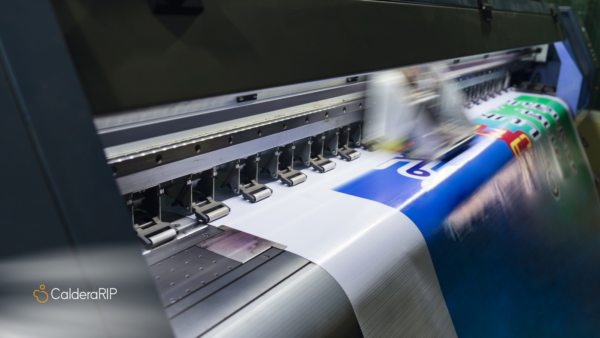
Why Prepress Automation is Essential for Large-Format Printers
May 22, 2025
Your production floor is buzzing with top-tier equipment. You’ve invested in the best printers money can buy. But somehow, jobs still get delayed, overtime costs pile up, and your team keeps playing file-fixing detective instead of printing.
Sound familiar? Welcome to the prepress traffic jam.
While you manually tweak files, battle color inconsistencies, and piece together inefficient nesting layouts, your competitors are cranking out nearly triple the jobs. That’s right — according to NAPCO Research, shops with automated prepress workflow process 355 jobs daily compared to just 125 for the manual crowd.
What’s their secret? They’ve figured out that in large-format printing, the bottleneck isn’t your printer speed — it’s everything that happens before the file hits the RIP.
So, let’s cut through the tech jargon to show you three real-world reasons why prepress workflow automation isn’t just for the big players anymore. You’ll see exactly how print shops like yours process more jobs, waste less material, and deliver better quality without working their teams to death.
Because let’s face it — you didn’t get into large-format printing to become a file correction specialist. You got in to print awesome stuff and make money doing it.
Reason 1: Enhanced efficiency and productivity (aka getting more done without losing your mind)
When NAPCO Research found that highly automated print shops process 355 jobs daily versus just 125 for the manual crowd, it wasn’t just throwing numbers around. It was exposing the brutal reality of modern print production workflow.
Think about it. Every file that lands in your inbox brings its own special problems — missing fonts, RGB images in a CMYK workflow, incorrect bleed settings — the list goes on. When your team handles these issues manually, they’re basically performing the same detective work over and over, file after file, day after mind-numbing day.
Automation changes the game entirely. It standardizes your processes and eliminates those time-sucking manual interventions that bog down your production. Those repetitive tasks that eat up hours of your day? Gone. The preproduction errors that lead to costly reprints? Dramatically reduced. Your staff suddenly has time to focus on the complex, creative work they actually enjoy — you know, the reason they got into this business in the first place.
The math is simple: Automation lets you handle more jobs without hiring more people. Your scheduling becomes smarter, with similar jobs automatically grouped for efficient gang runs. Your resource allocation improves because you’re not wasting skilled talent on mundane file corrections. And perhaps most importantly, you stop being the print shop that’s always running behind and become the one that consistently delivers on time, even with tight deadlines.
Reason 2: Cost reduction and waste minimization (where your bottom line gets a serious boost)
The efficiency gains are impressive, but let’s talk money — because that’s what keeps your shop’s doors open at the end of the day. Every time your team manually intervenes in a file, you lose both time and cash and in large-format printing, where substrates come with premium price tags, mistakes get expensive fast.
Here’s the truth: Those manual touchpoints in your workflow function as financial liabilities. Every time someone touches a job, the opportunity for error increases, and errors equal waste. That explains why the NAPCO survey found that 88% of highly automated print shops report significant reductions in errors and reruns. They’ve eliminated the costly human touchpoints where mistakes typically happen.
Take nesting, for example. When done manually, even your best prepress operator wastes substantial material. However, software like Caldera’s PrimeCenter automatically calculates the most efficient layout, slashing media waste by up to 20%. On expensive substrates, that becomes serious money flowing directly to your bottom line.
Think about what a 20% reduction in material waste means across your operation for a year. Now add the savings from fewer reprints, less overtime, and reduced labor costs. Suddenly, that investment in prepress workflow automation transforms from a cost into one of your smartest financial moves.
Reason 3: Improved quality and consistency
Now that we’ve covered the productivity and cost benefits, let’s talk about what your clients actually see — the quality of your work. Because in large-format printing, inconsistency kills client relationships faster than missed deadlines.
Ever had a client who needed their brand colored a specific hue of blue to match precisely across three different substrates? Or a retail chain that needed identical window graphics in 50 locations? Without automation, these jobs become nightmares of manual adjustments and crossed fingers.
Automated prepress workflow eliminates these quality variables by standardizing every step of your process. Your color management becomes precise and reliable — the same Pantone match every single time, regardless of substrate or which operator processed the file. Your cut paths generate automatically with perfect registration marks. Those pesky file issues that once caused unexpected print failures? Your system catches and fixes them during automated preflight before reaching the production floor.
Better yet? The impact goes beyond just looking good. When clients can count on you for absolute consistency job after job, you become their go-to printer, not just another vendor. They stop micromanaging every proof because they trust your output. They bring you more complex, higher-margin projects because they know you’ll nail the details. And that in itself separates you from the pack.
Stop Watching your competitors pull ahead: the time to automate is now!
The verdict is clear: Automated prepress workflow has moved from “nice-to-have” to “survive-and-thrive” territory for large-format print operations. Your competitors are already processing triple the jobs with fewer errors and less waste while delivering consistently superior quality. And every day you stick with manual processes, that gap widens — along with the difference in your respective bottom lines. We’ve all been there — hesitating on the investment, worrying about implementation headaches, questioning if the ROI is real. But ask yourself: How much is another year of prepress bottlenecks costing you?
At Caldera, we developed our software suite after spending thousands of hours with print professionals like you, watching where your workflows break down and your profits leak away. CalderaRIP and PrimeCenter tackle the daily frustrations unique to large-format operations — color inconsistencies, substrate waste, and repetitive file corrections that drain your team’s energy. Many automation systems feel like they were built by programmers who never set foot on a print floor, but we built ours differently. When print shops switch to our system, they typically see dramatic improvements within weeks, not months, and we have the track record to back it up.
Ready to stop wrestling with yesterday’s workflow problems? Let’s talk about how Caldera can transform your operation — starting tomorrow.
Related articles


